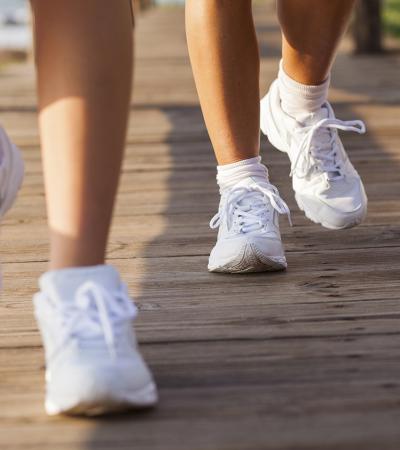According to America Walks, “good health is not the only benefit of walking. In fact, there is a broad range of individual and community benefits that accrue when people walk more often and when communities are designed to make walking safe, enjoyable and convenient.” The benefits include safe neighborhoods, healthy communities, social equity, environmental sustainability and even improved economies.

This month, I’m highlighting nine ways you can get incorporate walking into your library programs all year round. Each program focuses on a different type of community partnership.
1. Create a DIY StoryWalk® with scouts
A StoryWalk is a way for people to enjoy reading and the outdoors at the same time. Laminated pages from a children's book are attached to wooden stakes and installed along a path. As you walk down the trail, you're directed to the next page in the story.
More and more libraries have set up permanent StoryWalk installations in which the books can be rotated out periodically. These installations don’t grow on trees! Team up with Boy Scouts and Girls Scouts to bring this program to your community.
2. Create a StoryWalk® with your state library or local parks and rec
Another way to bring a permanent StoryWalk® to your community is by securing funding from your state library agency.
At least two libraries here in North Carolina have gone this route: our largest library, based in Charlotte, and one of our rural library systems, the Appalachian Regional Library System, on the crest of the Blue Ridge Mountains. Both used the money they received from the state library to broker long-term partnerships with multiple parks and recreation agencies in their communities.
Want to learn more? Check out this free webinar to learn about Charlotte-Mecklenburg's story, and visit this Appalachian Regional Library libguide to learn about the rural Appalachian program. Also read my earlier blog post for advice about working with parks and rec.
3. Make StoryWalk® for older readers and adults
Why should kids have all the fun? Once you set up a StoryWalk® program, you can do whatever you want with it. Some libraries work with adult education programs to feature poems written by adult literacy learners, others work with state parks to put poems along trails, and still others feature local history by highlighting historical photographs. The possibilities are endless!
4. Host a Walking Book Club with your local rec center
Since 2009, the Gail Borden Library in Elgin, Illinois, has had a Walking Book Club that starts and ends at the library every week. Key to the success of this program has been a robust partnership with the local rec center. When the weather is good, group members walk outside. When weather is bad, they utilize an indoor track at a rec center across the street from the library.
Don’t have a track next door? Consider other options! In the tiny town of Boonville, North Carolina (population 1,222), the library’s Crosswalk Support Group wometimes walks around a big church next to the library. Use the spaces and partners you have available.
5. Host a Walking Book Club with your bookmobile
Maybe your library is not a good location for the start of a walking book club. No worries; the club can start offsite.
That's how the Lewis & Clark Library Bookmobile in Montana runs their walking book club. Each month the club reads a chosen book, and then when the bookmobile stops in the park, the group takes a walk as they discuss it. Tea and snacks are available afterwards at the Bookmobile.
6. Connect walking with local historians and artists
American Libraries magazine highlighted in 2017 how more libraries are organizing walking history tours, frequently led either by local history librarians or enthusiastic local historians. In addition to local history walks, you can think about walking ghost tours or walks focused on public art like murals or sculptures.
7. Walk with a Doc® at your library
With an aim to make hope and health accessible to all, the national nonprofit Walk with a Doc® seeks to support healthcare provider-led walks in communities across the country.
Denver Public Library has embraced the movement by hosting their local Walk With a Doc®. You can too! Check out the movement’s website to see if a chapter is near you; if not, team up with your local healthcare provider to start one.
8. Do a walkability assessment
Another approach to adding walking to your programming is by embracing citizen science. One of the key tools used by public health scholars and practitioners focused on fostering walkable neighborhoods is the walkability assessment.
At the St. Louis County Library in Missouri, three branches teamed up with the St. Louis County Older Resident Programs (CORP) and Oasis to offer walkability assessment programs featuring one-mile guided walks around the library’s neighborhood in which the sidewalks and surrounding areas were assessed for pedestrian safety by older adults who participated. At the end of the walk, everyone met back in the branch to discuss findings and ways to improve pedestrian safety.
9. Team up with national initiatives to map safe walking routes
Did you know that there multiple national nonprofits and federal initiatives focused on increasing the walkability of America’s communities, big and small? A few of the more prominent include America Walks, Safe Routes to Schools and the Centers for Disease Control & Prevention (CDC). Libraries have worked with them all, and you can too.
In High Point, North Carolina, the library got a 2018 Community Change Grant “to create maps of the routes to be given out at the High Point Public Library, where the High Point Farmers Market is located on Saturday mornings.” In Palo Alto, California, the library jumped on the Safe Routes to Schools bandwagon by adapting to the library and mapping safe routes to walk and ride to local library branches.
And at the national level, the CDC includes public libraries in its Connecting Routes + Destinations initiative, which focuses on ensuring that anchor institutions like public libraries can be accessed by walking, bicycling, wheelchair and public transit.
And since nine isn’t enough, here are seven more walking program ideas from the Programming Librarian website.
- Wise Walk
- Snowshoe in February
- Middle Earth Walking Challenge
- Library Walking and Running Clubs
- Little Havana Walking Tour
- Roaming Readers Walking Club
- Want to Know Your Community? Get Outside
Made it this far and still looking for more? For the truly hard-core, please check out the peer-reviewed research article I wrote about this trend last year. It’s available open access in the International Journal of Environmental Research and Public Health.


